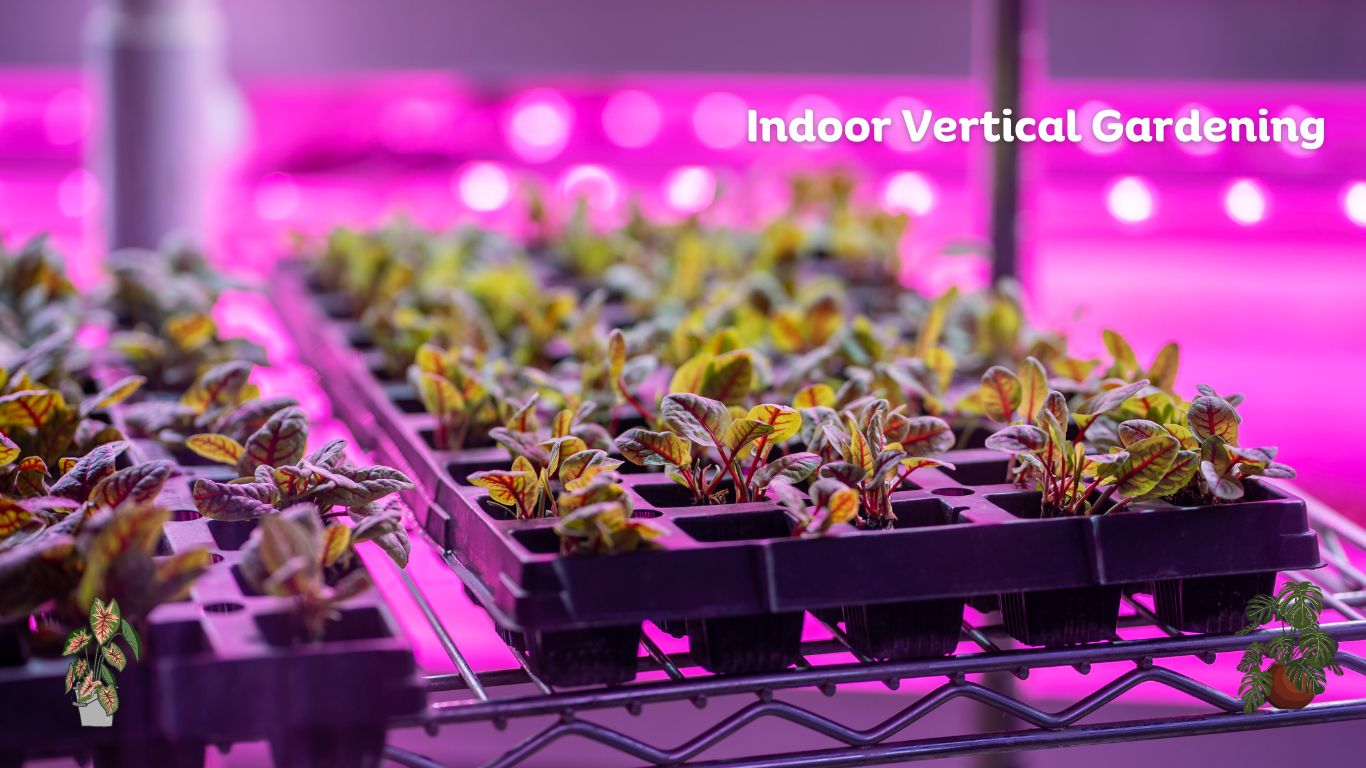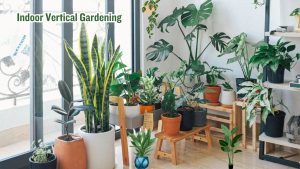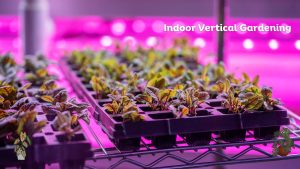Indoor Vertical Gardening Tips | A Complete Guide

Indoor vertical gardening has become a popular solution for people living in small spaces who want to grow vegetables, herbs, and flowers. Whether you’re a beginner or an experienced gardener, vertical gardening offers an excellent way to maximize space while bringing greenery’s beauty and health benefits into your home. This guide on indoor vertical gardening tips will help you establish a thriving indoor vertical garden, from choosing the right plants and materials to ongoing maintenance and care.
What is Indoor Vertical Gardening?
Indoor vertical gardening involves growing plants in vertical structures or wall-mounted systems rather than traditional horizontal garden beds or pots. The system can range from simple DIY setups to advanced hydroponic or aeroponic designs. The goal is to optimize space by growing upwards rather than outwards, which is particularly beneficial in small apartments or homes with limited outdoor space.
Vertical gardens are not only aesthetically pleasing but also functional. They can improve air quality, reduce stress, and even produce fresh food year-round. For those new to this form of gardening, mastering key indoor vertical gardening tips will lead to success and satisfaction.

Best Indoor Vertical Gardening Tips for Beginners
1. Choose the Right Location
The foundation of a successful indoor vertical garden is selecting the proper location. The ideal spot should have ample natural light, especially if you plan to grow sun-loving vegetables or herbs. A south-facing window is perfect because it provides the necessary 6-8 hours of sunlight most vegetables require. If your space doesn’t get enough natural light, consider investing in full-spectrum LED grow lights.
Light is one of the most important factors in any indoor gardening setup, so ensure your plants receive the proper amount. If you’re a beginner, this is one of the most valuable indoor vertical gardening tips for beginners.
2. Select Suitable Plants
Not all plants thrive in indoor environments, especially when growing vertically. Some plants that do well include herbs like basil, parsley, mint, and thyme. Vegetables such as lettuce, spinach, kale, cherry tomatoes, and small peppers are excellent choices for vertical gardens.
Consider choosing dwarf or compact varieties that don’t require extensive space or root systems. This is crucial when selecting the right plant for your indoor vertical garden. Growing vegetables and herbs that suit indoor conditions is one of the best indoor vertical gardening tips you can follow.
3. Select Proper Containers and Systems
One of the most important indoor vertical gardening tips is to select the right system or containers. There are many options available for vertical gardening, including:
- Wall-mounted pots: These can be arranged in rows on walls, perfect for small plants or herbs.
- Stackable planters: These multi-layered systems allow you to grow various plants in a compact space.
- Hydroponic systems: A soil-less growing method where plants thrive on a nutrient solution. This method saves space and is often ideal for indoor vertical gardens.
When choosing containers, ensure they have proper drainage to avoid waterlogging, which can lead to root rot.
4. Use High-Quality Potting Soil
Indoor plants, especially those in vertical gardens, benefit from high-quality potting soil that provides the right balance of nutrients and moisture retention. Avoid using garden soil, as it might contain pests or diseases that could harm your plants. You can improve the fertility of your potting mix by adding compost or organic fertilizers.
5. Maintain Proper Watering Practices
Watering is crucial for indoor vertical gardens. Overwatering can lead to root rot, while underwatering will stunt growth and lead to wilting. Regularly check the moisture level of your soil by touching the top inch—if it feels dry, it’s time to water.
For vertical gardens, it’s essential to make sure water reaches every level evenly. A drip irrigation system or self-watering planters can be helpful, ensuring each plant receives the water it needs. This is one of the most practical indoor vertical gardening tips.
6. Optimize Air Circulation
Good ventilation is often overlooked but is vital in any indoor gardening setup. Proper airflow prevents the buildup of mold and mildew and discourages pests. You can use small fans to improve circulation, which helps keep your plants healthy.
7. Fertilize Wisely
Plants grown indoors can quickly exhaust the nutrients in their soil, making fertilization necessary. Use a balanced, water-soluble fertilizer designed for vegetables. Organic options, such as compost tea or seaweed extract, can also be beneficial for providing essential nutrients. Follow the product’s instructions to avoid over-fertilization, which can harm your plants.
8. Prune Regularly
Pruning is essential to maintaining a healthy and manageable indoor vertical garden. Regularly trim dead or yellowing leaves to keep your plants looking vibrant. This also prevents the spread of disease and improves overall airflow.
If you’re growing vining plants like tomatoes or cucumbers, use supports like stakes or trellises to help them grow upwards and maintain their structure.
9. Rotate Crops
Crop rotation isn’t just for large outdoor gardens. In an indoor vertical garden, it’s important to switch up the plants you’re growing in each spot or container to avoid depleting the soil and preventing diseases from building up. This is a key indoor vertical gardening tip to ensure long-term success.
10. Monitor for Pests and Diseases
Indoor gardens are not immune to pests or diseases. Regularly inspect your plants for any signs of infestation, such as small holes in leaves, discolored spots, or wilting. If you spot any pests, consider using natural solutions like insecticidal soap or neem oil. Isolating infected plants is crucial to preventing the spread of disease to your entire garden.
11. Harvest at the Right Time
The best part of growing an indoor vertical garden is the harvest. Pick herbs and vegetables when they are at their peak of ripeness for the best flavor and nutritional value. Harvesting regularly also encourages more growth and keeps your garden productive.
![]()
How to Build a Vertical Garden Indoors?
Building an indoor vertical garden can be as simple or complex as you like, depending on your needs and available space. Follow these steps to create a vertical garden in your home:
Step 1: Choose the Space
Find a wall or area with enough light, or plan to install grow lights. Measure the space to ensure your vertical garden will fit.
Step 2: Choose the Structure
Decide on the type of vertical garden you want. This could be as simple as wall-mounted pots, a freestanding trellis system, or a more sophisticated hydroponic setup.
Step 3: Install Containers
Install your containers, making sure they are securely attached to the wall or structure. Ensure they have adequate drainage to prevent waterlogging.
Step 4: Plant Your Garden
Fill your containers with high-quality potting mix and plant your chosen herbs, vegetables, or flowers. Make sure to space plants appropriately to allow for growth and airflow.
Step 5: Maintain Your Garden
Water, fertilize, and prune your garden as needed. With proper care, your indoor vertical garden will thrive, providing fresh produce and a beautiful green space in your home.
How Do You Maintain an Indoor Vertical Garden?
Maintaining an indoor vertical garden is simple when you follow the basic principles of watering, pruning, and fertilizing. Here are some key maintenance indoor vertical gardening tips:
- Water regularly, but don’t overwater. Ensure your plants have sufficient drainage.
- Fertilize every few weeks with a balanced fertilizer to replenish nutrients.
- Prune dead leaves and stems to promote healthy growth.
- Check for pests frequently and deal with infestations promptly.
With regular care and attention, your indoor vertical garden can flourish for many years.
FAQs on Indoor Vertical Gardening
1. What are the best plants for an indoor vertical garden?
The best plants for an indoor vertical garden include herbs like basil, mint, and thyme, as well as leafy greens such as lettuce, spinach, and kale. Compact vegetables like cherry tomatoes and peppers also do well in vertical gardens.
2. How do I know if my indoor vertical garden has enough light?
Place your garden near a south-facing window for maximum sunlight. If natural light is insufficient, supplement with full-spectrum LED grow lights to ensure your plants receive at least 6-8 hours of light per day.
3. Can I grow flowers in my indoor vertical garden?
Yes, many flowers can thrive in an indoor vertical garden. Consider choosing low-maintenance varieties like petunias, pansies, or marigolds, which add beauty and color to your space.
4. How do I prevent pests in my indoor vertical garden?
To prevent pests, ensure proper air circulation and regularly inspect your plants. If pests appear, use natural remedies like insecticidal soap or neem oil to manage infestations.
5. What kind of fertilizer should I use?
A balanced, water-soluble fertilizer designed for vegetables works best for indoor vertical gardens. Organic options like compost tea or seaweed extract can also promote healthy growth.

Question and Answer Section:
Q: How do you maintain an indoor vertical garden?
A: Maintaining an indoor vertical garden involves regular watering, proper lighting, occasional fertilization, and pruning. Monitoring for pests and diseases is also essential for keeping your plants healthy.
Q: How to build a vertical garden indoor?
A: To build a vertical garden indoors, choose a space with enough light, select the appropriate structure (such as wall-mounted pots or stackable planters), and install containers. Use high-quality soil, plant your chosen herbs or vegetables, and maintain them with proper care.
Q: Is an indoor vertical garden difficult to maintain for beginners?
A: Indoor vertical gardens are relatively easy to maintain, even for beginners. By following basic indoor vertical gardening tips such as choosing the right plants, providing adequate water, light, and ventilation, you can keep your garden healthy and thriving.
With these indoor vertical gardening tips, you’re well on your way to creating a productive and beautiful garden right inside your home. Happy gardening!

One Comment